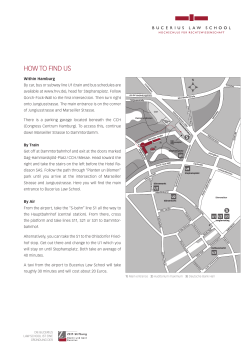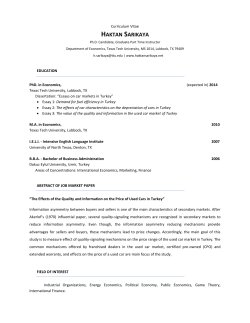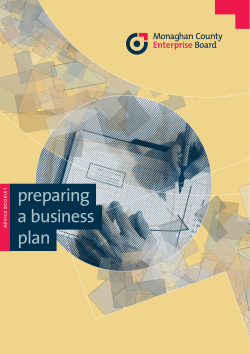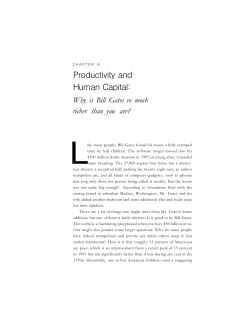
Document 169240
Economics: Performance Assessment Idaho Department of Education The High School Entrepreneur: Researching and Writing A Small Business Plan “If land, labor, and capital are the essential ingredients for creating all goods and services, who pulls these resources together? The answer is entrepreneurs. Entrepreneurs are ambitious leaders who decide how to combine land, labor, and capital resources to create new goods and services. They are the individuals who take risks to develop original ideas, start businesses, create new industries, and fuel economic growth.” Economics: Principles in Action, Prentice Hall, 2001 Performance Assessment for ECONOMICS The High School Entrepreneur: Researching and writing a small business plan Developer: Kim Grimes, Boise IDAHO DEPARTMENT OF EDUCATION ID Economics Performance Assessment - 2 Carolyn Mauer, Bureau Chief, Curriculum and Accountability Dr. Dan Prinzing, Social Studies Coordinator P.O. Box 83720 Boise, ID 83720-0027 208/ 332-6974 TABLE OF CONTENTS List of Student Projects…………………………………………………….3 I. Introduction ………………………………………………………….4 II. Identifying a Product or Service……………………………………..5 III. Market Research……………………………………………………..8 IV. Naming your Product……………………………………………….10 V. The Executive Summary……………………………………………12 VI. The Marketing Plan…………………………………………………13 VII. The Management Plan………………………………………………20 VIII. The Financial Plan………………………………………………….24 IX. The Strategic Plan…………………………………………………..28 X. Final Projects……………………………………………………….29 Works Cited……………………………………………………………….30 Appendix…………………………………………………………………..31 ID Economics Performance Assessment - 3 List of Student Projects Page 1. Interview 5 2. Industry Trend 7 3. Selecting a Product or Service 7 4. Market Research Studies 9 5. Selecting a Name 10 6. Trademark Registration 11 7. Executive Summary 12 8. Compare/Contrast Marketing Chart 13 9. Marketing Plan 13 10. Advertising 19 11. Type of Business Organization 20 12. Management Skills 21 13. Personnel Strategies 23 14. Start Up Costs 24 15. Fixed/Variable Costs 25 16. Personal Assets/Collateral 25 17. Business Loan Application 26 18. Break Even Analysis 27 19. 3 Year Projection 27 20. Strategic Plan 28 21. Title Page and Table of Contents 29 22. Final Summary 29 23. Assemble Your Final Products 29 ID Economics Performance Assessment - 4 I. Introduction Throughout your Economics course this semester, you will apply your classroom knowledge to real business world tasks. You will simulate actions of a true entrepreneur as you create a portfolio of projects that involve gathering current business information and interacting with your community. The information you obtain and decisions you make will allow you to complete your primary portfolio goal: to design a small business plan for a product or service that you can successfully sell to consumers in the current economy. Many of your tasks will serve as actual components of your small business plan; others will guide you to make decisions about these components. All the projects will help you answer countless questions as you prepare to operate a business, such as: • • • • • • • • What type of product/service should I sell? Who will purchase my product and why? Who are my competitors? How will I advertise or market my product? How will I determine the price of my product? What kind of business will I operate and manage? How much money and capital do I need to start my business? What are my short and long term goals for my business? Although this portfolio will conclude with the written business plan, you will ultimately be the one to decide if you wish to launch your plan into action. Part of this portfolio will guide you to assess the qualities that successful entrepreneurs possess and help you decide if you have the interest and ability to promote your ideas into a real business world success. Starting and operating a small business is a difficult task. Many small business attempts fail because entrepreneurs neglect to research their ideas, establish goals or to document their plans. This portfolio is designed to help you avoid these pitfalls by allowing you to gather the ideas, formulate the plans and write the documents necessary to initiate a successful business venture. ID Economics Performance Assessment - 5 II. Identifying a Product or Service 1 In order to design a small business plan, you must identify a product or service that you can successfully sell in the current economy. Considering doing something you love is a start, but it has to be further analyzed by examining the market potential, competition, resources required to enter the market, consumer/buyer demand, and uniqueness of the idea. The best place to start in picking a small business is with consumers (including other businesses that may want your product or service). What do consumers or businesses want that's not being provided to them? Ultimately, whether you succeed will depend upon whether you are able to meet some unmet need in the market. In fact, if you love to cook, you may be more likely to succeed if you open an interior decorating service — even if you know nothing about interior decoration — than you would be if you open a catering service, if there is a demand for interior decorating services but not for another catering company in your area. It's far easier to hire someone who knows something about interior decoration than it is to sell consumers something that they don't want. Of course, you don't necessarily have to sell a new or different product or service in order to succeed; you can succeed if you can improve what is already being sold. In the above example, you should open a catering business if you can provide a better service than other catering businesses, such as a wider menu or lower prices. But that's still a function of what consumers want. Your research would have told you that there is a demand for a new catering business if prices were lower or if the menu were more varied. PROJECT #1 – Interview Interview a small business owner in your community about his/her choice of product or service: how did the entrepreneur decide to sell this particular product? What research did he/she do? Has it been a successful choice? (A good resource is the SCORE (Service Corps of Retired Executives) office in Boise if you need suggestions for names of small business owners (208) 334-1696 x 228). Write a one page summary describing the product ideas that this entrepreneur considered when establishing his/her business. Include a section on the entrepreneur’s happiness or regrets about the product he/she is selling as well as any advice he/she would give to a young entrepreneur. 1 Reproduced with permission from CCH Business Owner’s Toolkit ™ published and copyrighted by CCH Incorporated, 2700 Lake Cook Road, Riverwoods, IL, USA 60015. May 30, 2002. www.toolkit.cch.com. ID Economics Performance Assessment - 6 Now, how can you decide what consumers want? A good place to start is with the mainstream press: The New York Times, The Wall Street Journal, Time, U.S. News and World Report, Newsweek, USA Today and your local/state newspapers. You should also look at the business press: Fortune, Forbes, Business Week, or any of the other business periodicals to which you have access. When you read them, look for trends that may be emerging, not just in business but in our culture at large. To give you some idea of what you should be looking for, here are three examples of current trends and how you might take advantage of those trends for a small business success.2 Trend #1: Increasingly, husband and wife are both wage earners. This means that many couples don't have the time or energy to perform tasks that were most commonly performed by the wife. How can you fill in the gap? Some business ideas are: child care provider, grocery delivery service, house-cleaning service, interior decorator, dog walking service, household manager, and gift purchase and delivery service. Trend #2: In an effort to cut costs, many companies have laid off employees. This means that companies are increasingly looking outside of the company to perform tasks previously performed in-house. In business-speak, it's called outsourcing. Ask yourself: which tasks are businesses most commonly outsourcing? Some business ideas are: copywriting services, legal and paralegal services, billing and other human resourcesrelated services, public relations services, and meeting planning. Trend #3: Computers are now everywhere. Many businesses, however, lack the inhouse expertise they need to take full advantage of the emerging technologies. How can you meet the need? Some business ideas are: Web site developer, graphics designer, desktop publisher, and database consultant. In addition to reading newspapers and magazines, you should talk to friends, relatives and other small business owners about ideas they may have or needs in the market they don't believe are being met. And, last but not least, don't forget the often most overlooked resource - yourself. You're a consumer. If you've wished that a particular service were available, chances are that others have too. Also, when you think about market opportunities, think about how you can improve upon a product or service that is already being provided. But be aware that there are at least two potential stumbling blocks here. The first is the tendency to believe too readily that you can improve upon an existing product or service. This is just old-fashioned overconfidence. Be sure that you've thought through the specific things you can do to improve what's already out there. 2 Reproduced with permission from CCH Business Owner’s Toolkit ™ published and copyrighted by CCH Incorporated, 2700 Lake Cook Road, Riverwoods, IL, USA 60015. May 30, 2002. www.toolkit.cch.com. ID Economics Performance Assessment - 7 The second is the fact that being able to improve upon a product or service is no guarantee of its success. In other words, you must be sure not only that you can improve what's already there, but also that there is also a demand for the improvement. PROJECT #2 – Industry Trend Choose one of the newspapers or periodicals listed previously and locate an article or reference to an industry trend. Summarize the information you read and attach a copy of your source. PROJECT #3 – Selecting a Product or Service Brainstorm a list of products or services that you might be successful selling. Record this list. Next, choose a product or service to sell! Your product may or may not follow one of the trends you noticed, but you should justify your choice. Summarize (1-2 paragraphs) your product idea and give reasons for selecting your product or service. Include any talents you possess, ideas for future gains and/or other considerations you have made which will help guarantee your product will sell. You will use these ideas for your Executive Summary page in your small business plan, but you will research and investigate your product market in detail for your Marketing Plan. ID Economics Performance Assessment - 8 III. Market Research3 Today the world is defined by the term "information age." All businesses require accurate and timely information to be successful. Whether your company is large or small, the right amount of financing, equipment, materials, talent, and experience alone are not enough to succeed without a constant flow of the right business information. Many large companies make market research into a very sophisticated and lengthy process, so that they can find out everything possible about their customers. For example, Philip Kotler, author and economist, writes in Marketing Management, "Coke knows that we put 3.2 ice cubes in a glass, see 69 of its commercials every year, and prefer cans to pop out of vending machines at a temperature of 35 degrees . . . We each spend $20 per year on flowers; Arkansas has the lowest consumption of peanut butter in the United States; 51 percent of all males put their left pants leg on first, whereas 65 percent of women start with the right leg; and . . .P&G once conducted a study to find out whether most of us fold or crumple our toilet paper. . ." While you probably won't be able to afford a separate marketing research department to gather and monitor all the information that could possibly help you, all successful business owners must know their markets, competitors, customer wants and needs, and "what it takes to be competitive." It is not enough to know the answers to what, where, when, and how questions about our businesses. We also need to know why people buy our products and services. You should expect to budget at least a minimal amount of time and money for research, especially if you are starting a new business or branching out into a new direction. Market research procedures: Generally, market research procedures break down into the following categories: • Primary research: This research involves the actual data-gathering about the specific usage patterns, product feature likes and dislikes, etc., of target buyers or current users of your product. It may be completed with personal interviews, phone surveys and/or other types of written or verbal “polling” of consumers. This research is most valuable when you need a general feel for how/what consumers think about your product category. It is important to survey the appropriate group of consumers (those who will be purchasing/using your product) and ask questions that will provide you with important information as you pursue your business venture. 3 Reproduced with permission from CCH Business Owner’s Toolkit ™ published and copyrighted by CCH Incorporated, 2700 Lake Cook Road, Riverwoods, IL, USA 60015. May 30, 2002. www.toolkit.cch.com. ID Economics Performance Assessment - 9 • Secondary Research: Most of us are familiar with secondary research from doing library research with books and periodicals. With secondary research, someone else has done the actual data gathering in the field and has written it up in a form that's easier for you to use. Secondary research is generally much less timeconsuming and cheaper than primary research. The internet is a key source for gathering information about industries. For example, if you choose to open a specialty pizza restaurant, you might conduct an internet search for “pizza industry.” This search returns Pizza Today Magazine and Pizza Marketing Quarterly, publications which provide valuable information about the pizza industry. A beauty salon owner might discover www.beautyexperts.com which gives beauty industry news, events, and tips for salons. PROJECT #4 – Market Research Studies Complete two market research studies. One study must be primary research using data you gather from consumers. Select and describe an appropriate target group for your product research. Include at least 100 responses. Describe the reasons for your particular test, poll or survey and how it will help your business. Include the data results and your final analysis of this research: what did you learn from the results? The other study must be secondary research from trade publications or industry journals. Good resources for secondary research are your library, the internet and the Chamber of Commerce. The American Marketing Association may be able to help you as well (311 S. Wacker Drive, Suite 5800, Chicago, IL 60606, 1-800-2621150). Locate at least two industry/trade journals for your product and write a 1-2 page summary of the successes, failures, advice and/or trends you see about your particular industry and how it will affect your business decisions. Make sure to reference your sources. ID Economics Performance Assessment - 10 IV. Naming your Product4 Naming your business is a critical step for a business owner. Use these considerations when selecting a name for your business: • • • • • • • • The name should be easy to understand, spell, pronounce, remember and find in the telephone directory. Does the name help describe the image you want for your business? Can your actual product be listed as part of the name? (e.g. Domino’s Pizza ®) This may help consumers to remember your name. Individual letters or acronyms may make the name difficult to find in the telephone directory. You may wish to avoid punctuations to help the alphabetized placement, making your business easier to locate. Since businesses are listed with the first word, choose your first word (e.g. “The”, “A” or “An”) carefully. Avoid unusual spellings such as “Kar” for “Car” to prevent confusion. Avoid names similar to those used by another business. Terms such as Corp., Inc., or LLP may only be used for businesses structured in such a manner and registered correctly. PROJECT #5 – Selecting a Name Select a name for your product using the considerations above. Write a short paragraph to summarize how you determined your product name. Next, consult the white and yellow pages. What businesses are listed directly before and after the spot where yours would be in the white pages? Under what category(ies) would your business be listed in the yellow pages? If applicable to your business, you may want to apply for trademarks, patents and/or copyrights. Trademarks are symbols, designs or words used to distinguish a business or product from its competitors. Any time you claim rights to a mark, you may use the "TM" (trademark) or "SM" (service mark) designation to alert the public to your claim regardless of whether you have filed an application with the United States Patent and Trademark Office (USPTO) (e.g. TargetTM ). However, you may use the federal registration symbol "®" only after the USPTO actually registers a mark, and not while an application is pending (e.g. adidas® or Suave®).5 4 “Naming Your Business,” Entrepreneur’s Encyclopedia 2002: The Business Journal Phoenix 16 Nov 2001: 14B. 5 United States Patent and Trade Office, United States Department of Commerce on the World Wide Web. May 8, 2002. www.uspto.gov. ID Economics Performance Assessment - 11 U.S patents are issued to protect new and useful inventions. (Professional assistance from a patent attorney is strongly urged because patent procedures are detailed and technical. A patent search is performed to see if a patent currently exists on the same or nearly the same device and, if not, to make proper application with the Patent Office). Copyrights protect the thoughts and ideas of authors, composers and artists. A copyright prevents illegal copying of written matter, works of art or computer programs. In order to ensure copyright protection, the copyright owner should always include notices on all copies of the work.6 PROJECT #6 – Trademark Registration Visit or call the Idaho Secretary of State Office to find out what documents are necessary to register a business name. (www.idsos.state.id.us gives several phone numbers and contact information). Summarize your findings and include a completed form necessary for registering your trade name. Also, download or request and attach a ‘Trademark Registration’ form. If you choose to register a trademark, complete this form to describe your symbol or name in detail. If you choose to patent an invention or copyright a written piece, summarize the instructions given by the Idaho Secretary of State Office for patents or copyrights. 6 The Small Business Resource Guide 2002, CD-ROM, Rancho Cordova, CA: Internal Revenue Service, Western Area Distribution Center, 2002. ID Economics Performance Assessment - 12 V. The Executive Summary7 The research you have now done and the decisions you have made about your product have helped prepare you to write the opening page of your business plan. The Executive Summary is approximately a one page explanation of your business and its competitive advantage. It should provide a clear description of the industry you are competing in and what sets you apart from your competitors. It should answer these questions: • • • • • • What does your business do? What image will it have? What customer needs are met? What makes it unique from competitors? What volume of sales is expected? In what price range will it compete? PROJECT #7 – Executive Summary Use the three Executive Summaries from sample business plans in the Appendix as guides for your own summary.* Then write your own Executive Summary page, answering the questions above. * Note that Joe’s Redhots gives detailed information for his Sales Estimates since his plan is intended for a banking audience as he attempts to establish a business loan. Also, Ice Dreams provide a visual graph with specific target numbers. Your Executive Summary needs only to include a realistic estimate of your sales volume for a 1-3 year period (may be daily, monthly, weekly or annual sales). Net profit information can be determined later in the plan when you predict your start-up, fixed and variable costs and pricing strategies for your business. 7 “Drafting an Effective Business Plan,” Entrepreneur’s Encyclopedia 2002: The Business Journal Phoenix 16 Nov 2001: 19B-20B. ID Economics Performance Assessment - 13 VI. The Marketing Plan8 Following your Executive Summary, your business plan should include a detailed Marketing Plan which provides specific descriptions on these 5 factors: A. B. C. D. E. The Target Market Competition Location Analysis Price Determination Marketing Approach You will first evaluate 2 existing marketing plans and then use them as guides to create your own plan to market your product. PROJECT #8 – Compare/Contrast Marketing Chart Read the marketing plans of Ice Dreams and Joe’s Redhots found in the Appendix. Next, complete the compare/contrast chart (pages 14-18). Answer the questions relating to the above 5 factors for both businesses. Both marketing plans provide enough information to answer most questions. However, if you cannot determine an answer or give a probable response based on the information you read, mark the question “Not Applicable” for that business. After completing the chart, circle the areas where the 2 businesses used similar techniques and star the sections which were unique to only one business. Then select the business you feel has the most effective marketing plan for its product. Write a one paragraph summary to justify your choice. PROJECT #9 – Marketing Plan Organize and write your own Marketing Plan according to the 5 factors listed above and on the chart. Your Marketing Plan must answer the questions found in the compare/contrast chart and may include additional marketing strategies that you identify to be valuable for your business. Use the sample marketing plans as formatting guides and make your plan easy to read. Use clear section headings, paragraphs and bullets when appropriate. 8 “Drafting an Effective Business Plan,” Entrepreneur’s Encyclopedia 2002: The Business Journal Phoenix 16 Nov 2001: 19B-20B. ID Economics Performance Assessment - 14 Marketing Category Ice Dreams Joe’s Redhots Target Market 1. What needs are sought by your customers that your product satisfies? 2. Describe your potential customer in detail (use those that apply): age, sex, income level, education, geographic location, occupational area, leisure interests, buying habits and personal goals. 3. Under what circumstances does your customer buy your product? 4. What is the expected size of your target market? 5. Of that target market, what is the expected volume of actual paying customers? ID Economics Performance Assessment - 15 Marketing Category Ice Dreams Joe’s Redhots Competition 1. Who are your major competitors? 2. Why are they successful? 3. What substitutes exist for your product? 4. What impact do these substitutes have on your sales? 5. What distinctive differences separate you from your competitors? 6. Why should customers leave your competitors to choose your product? ID Economics Performance Assessment - 16 Marketing Category Ice Dreams Joe’s Redhots Location Analysis 1. Where will your business be located? 2. How will this location enhance the sale of your product? 3. What strategic advantages do you have in this location? 4. Is there opportunity for expansion? How? 5. What are the neighboring businesses? Do they complement or detract from yours? 6. Are building renovations needed? At what cost? 7. Is the neighborhood stable? Deteriorating? Changing? How? 8. Are there zoning ID Economics Performance Assessment - 17 classifications for your business? 9. Describe customer access. Marketing Category Ice Dreams Joe’s Redhots Price Determination 1. What will be the unit cost(s) of your product? 2. How does your price compare with your competitors? 3. Why will customers pay your price? 4. What image will be projected at this price? 5. What special advantages do your customers get that is included in this price? ID Economics Performance Assessment - 18 Marketing Category Ice Dreams Joe’s Redhots Marketing Approach 1. Where (or from whom) do your customers seek information about purchasing your product? 2. Which media and promotions (e.g. newspaper, TV, radio, fliers, samples, etc.) are most suitable for your advertising? 3. How will your image be clearly and consistently conveyed to potential buyers? 4. How will you evaluate the effectiveness of each advertising and promotional effort? ID Economics Performance Assessment - 19 5. Will a sales staff be used? How? How will they be evaluated? Marketing Plan (continued) Your Marketing Plan required you to make advertising decisions. Now you must create one of these advertisements. Effective advertising includes something original that catches the consumer’s attention, provides them with information and helps them to remember your product. PROJECT #10 – Advertising Design and present an advertising piece or a promotional strategy to your class. This may be a video, sign, radio announcement, jingle, flier, newspaper ad, free sample, or any other advertising piece you would use to market your product. Attach a copy to your portfolio (if possible – otherwise attach a photo or script). ID Economics Performance Assessment - 20 VII. The Management Plan9 The Management Plan of a small business plan defines the type of business organization you wish to operate, your business experience and your hiring/employee management decisions. The first step is to decide on the type of business you wish to operate: sole proprietorship, partnership or corporation. Next you must describe your current business experience. This summary is similar to the skills you would list on a resume, but you will also include any skills of employees you plan to hire. Finally you must plan your hiring and training strategies, employee policies and wages/benefits for all personnel working with or for you. PROJECT #11 – Type of Business Organization You are familiar with the three main types of business structures and their pros and cons. Take the quiz entitled Free Enterprise – Choosing a Business Organization10 located in the Appendix. Complete the final line asking for your decision from the quiz results. On the back of the quiz write a short summary stating if you will keep the business organization outcome from the quiz or choose a different one – state your reasons. 9 “Drafting an Effective Business Plan,” Entrepreneur’s Encyclopedia 2002: The Business Journal Phoenix 16 Nov 2001: 19B-20B. 10 Free Enterprise Activities New York, NY: Glencoe/McGraw-Hill Companies, Inc., p. 3. ID Economics Performance Assessment - 21 PROJECT #12 – Management Skills Read the “Qualities of Successful Business Owners” on the following page. These are skills you may or may not yet possess, but are valuable for business success. Use this list as a guide to discuss your current business skills and experience that will contribute to a profitable business venture. Even if you feel your business experience is limited, concentrate on your strengths and talents that will enhance your particular business. Describe any jobs you have held and your responsibilities at these jobs. Give specific examples of where/how you used each skill that you list. Your summary is similar to writing a resume, but focused more on your talents as they relate to your specific business. It may also include a description of the talents/skills of the employees you will hire. Use bullets and formatting to make this page easy to read. Your summary should answer the following questions:11 • • • • • • • What is your education level? Include any specific courses that will help you in your business. What is your business background/work experience? How does your experience help you in this business? What are your strengths? What are your weaknesses? How will you compensate for them? Why are you going to be successful in this type of business? Who is on your management team? What skills do they bring to your business? 11 “Starting a Business.” Howard University Small Business Development Center on the World Wide Web. May 5, 2002. www.ntia.doc.gov/opadhome/mtdpweb/busplano.htm. ID Economics Performance Assessment - 22 Qualities of Successful Business Owners12 • • • • • • • • Willingness to sacrifice — you must be willing to accept the fact that, as a small business owner, you are the last one to be paid. Your bank, your vendors, and your employees are all in line ahead of you and must be paid before you see any of the money. You must also be willing to sacrifice much of what once was your free time to your business. If you like working nine-to-five, knowing how much you'll make, and taking three weeks of vacation every year, don't go into business for yourself. Strong interpersonal skills — if you thought that getting along with your boss was tough, wait until you have to deal with suppliers, customers, employees, lawyers, accountants, government officials, and everybody in between. Successful owners are able to work with all personality types, and they're able to find out from their customers what they like and don't like. Strong leadership skills — successful owners understand that others are looking to them to be led to the promised land. Others will be looking to you for answers, and if you're not ready for that responsibility, you probably shouldn't own your own business. Strong organizational skills — successful owners are able to keep track of everything that's going on in their business and they're able to set priorities and get things done. They know that if they lose track of what's going on, they're sunk. Intelligence — we're not talking about the ability to score well on standardized tests. We're talking more about street smarts and common sense. Successful owners are able to anticipate problems before they arise and to take preemptive steps to avoid them, and they know how to solve crises after they occur. Management ability — small business is all about managing relationships, with your customers or clients, with your employees, with your suppliers, with your accountant and lawyer, with your banker, and with your family. If you don't think you can effectively manage those relationships, you shouldn't start a new business. Business experience — without some solid business experience, you're probably not going to be able to borrow any money. Your banker will want to know about your experience, not just in business, but in the same field as the business you're hoping to start. If you lack the experience, go get it any way you can: volunteer at an existing business or try to get a part-time or weekend job in the field. Optimism — how will you react when business isn't going as well as your expected? A pessimist may fold the tent, but an optimist who believes in the business will keep going. Successful owners are optimists who are able to weather the rough spots. 12 Reproduced with permission from CCH Business Owner’s Toolkit ™ published and copyrighted by CCH Incorporated, 2700 Lake Cook Road, Riverwoods, IL, USA 60015. www.toolkit.cch.com. ID Economics Performance Assessment - 23 Management Plan (continued) PROJECT #13 – Personnel Strategies Locate and read a copy of one company’s Personnel Policies, Employee Rights and Responsibilities, Summary of Company Benefits and Policies or a similar document. Attach this copy and make sure to reference your source. Next write your own Personnel Strategies. You may choose to operate your business solo, but if you do plan to hire in the future, please discuss that option. Your section on Personnel Strategies should answer the following questions (use bullets and clear paragraph formatting to make it easy to read): • • • • • • • What are your personnel needs now and in the future? What are your hiring and training strategies? What are the duties of each person on your team? Who reports to whom? What and how will management and staff be paid? What benefits will be provided? (e.g. vacation, overtime, insurance, etc.) What are your specific personnel policies (e.g. dress code, work shifts, behavior on the job, etc.) ID Economics Performance Assessment - 24 VIII. The Financial Plan13 Sound financial management is one of the most important ways for your business to remain profitable and solvent. In your Financial Plan you will need to determine the amount of money needed to open your business (start-up costs) and the amount needed to keep it open (operating costs). Then you will have to evaluate how much money you currently have and how much you are able to acquire through loans or other resources. Finally you will predict the amount of money your business will make in the first few months of operation, allowing you to determine your expected net profit. Since your business is a realistic venture for a high school entrepreneur, several financial components/expenses such as legal fees or contractor fees may not be relevant. Still, business owners are required to file special taxes depending on the type of business they operate such as self-employment tax and income tax. Many small business owners hire an accountant to assist them with the details of these tax statements as well as other aspects of their Financial Plan. These projects will concentrate on your business cost needs and personal assets, but avoid the details of business taxation. Your aim as a young entrepreneur is not to become a financial wizard, but to understand the financial tools well enough to gain their benefits. PROJECT #14 – Start Up Costs Brainstorm a list of all the inventory, supplies, advertising, equipment/building and other needs you have before you can open your business. It may help to imagine a typical work day: what tools or supplies are you using at any particular moment? Be specific. Next, view the chart entitled “Start Up Dollars Needed” found in the Appendix. Use this chart as a guide to create your own start-up costs chart. Organize your chart into categories and find costs associated with each item. This is a time consuming process requiring much research to obtain realistic dollar amounts. Call stores, offices, landlords and other small business owners to gather your figures. In your chart, you must include a brief description of how you arrived at each figure (make a separate column). Perhaps some of your supply needs will be furnished free from friends/relatives or are already owned by you. Make sure to explain these situations in your description column. Remember this list includes all of the costs you must incur before you can even open your business. Total the column and label the amount “Total Start Up Dollars.” 13 “Drafting an Effective Business Plan,” Entrepreneur’s Encyclopedia 2002: The Business Journal Phoenix 16 Nov 2001: 19B-20B. ID Economics Performance Assessment - 25 Now you must determine all fixed costs (e.g. rent, equipment, insurance, salaries) and variable costs (e.g. office supplies, hourly wages, advertising) you will incur during your first 3 months of operation. Review the descriptions and examples of these costs in your textbook or class notes as you prepare to evaluate your own business costs. PROJECT #15 – Fixed/Variable Costs Make another cost chart with separate sections for fixed and variable costs over a 3 month period. Again, list the dollar amounts and descriptions of how you arrived at these figures. (View the “3 Month Operating Expenses” sample chart in the Appendix). Several of your categories may be repeated from your start-up costs chart. However, your totals for fixed costs should include the fixed amount for 3 months. Variable cost totals should include a range of values for 3 months, which is dependent on your business needs each month. Total these costs and label the amount “3-Month Operating Expenses.” (use a middle range value for adding your variable costs). Next you must evaluate your assets. Do you have enough cash or resources to finance all your expenses from start-up through the first 3 months? If not, you will have to seek loans. PROJECT #16 – Personal Assets/Collateral Make a list of all the assets you personally own and their values to be used as collateral for any loans you must incur. Include cash, bank account values and all property that you claim as your own. Total these figures and label the amount “Personal Assets.” Now add the amounts of your Total Start Up Dollars and your 3 Month Operating Expenses to find your Total Expenses. Next subtract your Personal Assets total to determine your Total Dollar Needs. Total Expenses: (–) Personal Assets: $_____________ $_____________ = Total Dollar Needs: $_____________ This final amount shows your estimated needs to open your business and to operate it for the first 3 months. As an entrepreneur you plan to make enough sales to offset these ID Economics Performance Assessment - 26 expenses, but you realize that it may take a few months to develop a business flow. Therefore, you may choose to apply for a business loan to finance these unmet expenses. PROJECT #17 – Business Loan Application Complete the 4-page sample Business Loan Application found in the Appendix. Your “Amount of Loan Requested” (page 2 of the application) should match the “Total Dollar Needs” you just calculated. Before completing the application, you may wish to review the following terms: creditor, guarantor, repayment terms, line of credit, term loan, bankruptcy, pension and profit-sharing. You are not required to gather the documents on the final checklist before you submit the loan application. Most apply to existing businesses with previous financial and tax statements. Since you expect to make a profit with your business, you need to learn how many products or services you must sell to first cover your expenses. This is called the breakeven point. Sales made after you cover your expenses are considered net profit. View the break-even analysis calculated by Trend Setters Hair Studio found in the Appendix. Notice that this business estimates charging about $45 per client. In order to cover their monthly costs of $5,691 they must service about 126 clients per month. (Prove this by dividing $5691 by $45. Note that the 127th customer will actually contribute to their profit). They have chosen to graph their total dollar break-even amount on the x-axis as a visual representation of their analysis. The break even point occurs where the line intersects with zero. An alternative graph might show the number of customers needed (126) on the x-axis to break even.14 14 Reproduced with permission from CCH Business Owner’s Toolkit ™ published and copyrighted by CCH Incorporated, 2700 Lake Cook Road, Riverwoods, IL, USA 60015. www.toolkit.cch.com. ID Economics Performance Assessment - 27 PROJECT #18 – Break Even Analysis Review the Total Expenses figure you calculated after Project #16. Remember that this figure included all start up costs and 3 months of operation costs. In order to calculate a monthly break-even analysis, you must use monthly cost figures. A simple analysis here requires dividing your Total Expenses by 3 to determine your average per-month cost. (However, realize that you may not cover all your start up costs in the first 3 months of operation and must absorb them into future months). Next, divide your average monthly cost by the unit price of your product or service (determined in your Marketing Plan). This is the total number of units you must sell each month to break even. Construct a graph to display this monthly break-even point. Include a description of your figures and a summary of whether or not these sales are realistically attainable. PROJECT #19 – 3 Year Projection Business Financial Plans also include a section to predict annual sales over a 3 year period. Use the information you obtained in your break-even analysis and your ideas for expansion to estimate a realistic sales forecast for the next 3 years. How much revenue do you expect to bring in each year? List and label these amounts and briefly explain how you calculated your figures. (Note that your profit from these revenues will vary according to your fixed and variable costs each month). The details of the Financial Plan that you just completed will be the cornerstone of your success. However it is vital that you maintain other financial statements during the operation of your daily business, for example: cash flow tracking (daily, monthly and quarterly), balance sheets of assets and liabilities, capital equipment lists (including depreciation) and tax statements. These detailed statements may be more manageable with the help of an accountant, but it is vital that you are aware of your company’s financial situation at all times. ID Economics Performance Assessment - 28 IX. The Strategic Plan The final piece of your small business plan includes a description of your future business goals. It describes how you intend to achieve these goals and is often referred to as the SWOT analysis (Strengths, Weaknesses, Opportunities and Threats). This Strategic Plan should focus on years two through five of your business. PROJECT #20 – Strategic Plan Write a 1-2 page summary of your short and long term goals for your company. Include bullets and/or paragraph formatting to make this easy to read. It should answer the following questions:15 • • • • What are the strengths of your business? What are the weaknesses of your business? What opportunities are available to you (and your competitors)? What threats may impede you (and your competitors)? The answers to these questions should describe strategies that use your strengths to not only take advantage of opportunities but also to overcome threats and reduce weaknesses. Include a section describing how your short term business goals (about 2 years) may vary from your long term goals (about 5 years) as well as business strategies that may change over the course of those five years. 15 “Drafting an Effective Business Plan,” Entrepreneur’s Encyclopedia 2002: The Business Journal Phoenix 16 Nov 2001: 19B-20B. ID Economics Performance Assessment - 29 X. Final Projects You have completed the final pieces of your business plan. Now you must prepare a Title Page and a Table of Contents PROJECT #21 – Title Page and Table of Contents Complete a Title Page for your business plan that is unique to your business. You may wish to use a logo or design, but it must contain the following information in a center-spaced format: • • • Business Name Address/Phone Number Owner Name (Your Name) Next, complete a Table of Contents page. It must include these sections and projects (with page numbers) in the following order: 1. 2. 3. 4. 5. Executive Summary (Project #7) Marketing Plan (Project #9) Management Plan (Projects #12,13) Financial Plan (Projects #14, 15, 16, 18, 19) Strategic Plan (Project #20) PROJECT #22 – Final Summary Write a one page summary describing your final thoughts on the potential success of your business. Discuss whether or not would like to put your plan into action and your reasons. Finally, comment on specific ideas or details that you have learned about being an entrepreneur from this portfolio project. PROJECT #23 – Assemble your Final Products Assemble the pieces of your small business plan (those projects listed in your Table of Contents) into a folder or binder. Next, organize your remaining projects and label them by project number. Combine the business plan and remaining projects into one portfolio and present it to your teacher as your final Economics Performance Assessment. ID Economics Performance Assessment - 30 Works Cited CCH Business Owner’s Toolkit ™ . Riverwoods, IL: CCH Incorporated. 30 May 2002 <www.toolkit.cch.com>. Entrepreneur’s Encyclopedia 2002: The Business Journal Phoenix 16 Nov 2001. Free Enterprise Activities New York, NY: Glencoe/McGraw-Hill Companies, Inc. “Ice Dreams.” Palo Alto Software, Inc. 5 May 2002 <www.paloalto.com>. The Small Business Resource Guide 2002. CD-ROM. Rancho Cordova, CA: Internal Revenue Service, Western Area Distribution Center, 2002. “Starting a Business.” Howard University Small Business Development Center. 5 May 2002 <www.ntia.doc.gov/opadhome/mtdpweb/busplano.htm>. “Trend Setters Hair Studio.” Palo Alto Software, Inc. 5 May 2002 <www.paloalto.com>. United States Patent and Trade Office, United States Department of Commerce on the World Wide Web. 8 May 2002 <www.uspto.gov>. ID Economics Performance Assessment - 31 Appendix Email dprinzing@sde.state.id.us to request a copy of the following handouts: 1. Executive Summary for Ice Dreams 2. Executive Summary for Joe’s Redhots 3. Executive Summary for Trend Setters Hair Studio 4. Marketing Plan for Ice Dreams 5. Marketing Plan for Joe’s Redhots 6. Teacher’s Key: Possible Answers for Project #9 – Marketing Plan 7. Free Enterprise – Choosing a Business Organization (Quiz) 8. Chart – Start Up Dollars Needed 9. Chart – 3 Month Operating Expenses 10. Business Loan Application 11. Break-Even Graph for Trend Setters Hair Studio ID Economics Performance Assessment - 32
© Copyright 2025





















